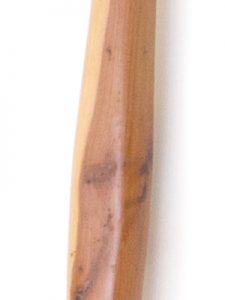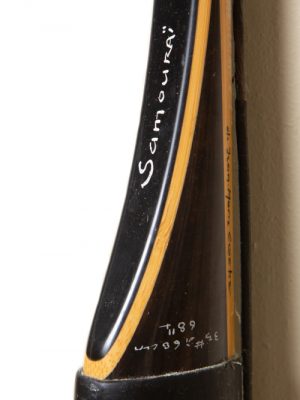The Holmegaard bow
Reproduction by Johann Tinnes
Discovered at Holmegaard in Denmark and reproduced in Germany
Original dated to the Mesolithic, circa 6500 BCE
Reproduction of the 20th century
Elm wood
Gift of Museum’s Friend Association, 1996
Inv.1996.04.11
______________
 In 1963, two bows were found in Holmegaard, Denmark. This type of characteristic Mesolithic bow was named after its discovery place: “the Holmegaard type”.
In 1963, two bows were found in Holmegaard, Denmark. This type of characteristic Mesolithic bow was named after its discovery place: “the Holmegaard type”.
One of these bows was almost complete although fractured in five. Currently measuring 5,05 ft, its original size is estimated around 5,58 ft.
As most mesolothic bows, it is made of elm. This wood is not as fitted as yew, but it has the particularity to be present in large quantity in the region, while being very straight and without knots.
Its method of fabrication, allowing the inner side to resist to pressure while letting the outer side expand, shows an extensive knowledge of the mechanical principles of a bow.
Its branches are large and flat but were slimmed down at the extremities to make them lighter and thus to reduce the strength necessary to bend the bow. The wood fibers were preserved. Indeed, none of them are ruptured, which strengthens the bow and protects it from breakage.
The handle is well defined and thinner to lessen the lateral deviation when the arrow is released, also called the “arrow paradox”.
These bows enable to shoot light arrows that can reach 111,85 mph in full power by an adult man. They were made in different woods and could be equipped with bulges used as blunt arrowheads to kill small animals without damaging their feathers and fur. For bigger preys, one used flint arrowheads to which barbs were attached with birch pitch.
This piece represents a major milestone in the knowledge that archeologists have of techniques used in prehistoric times.















